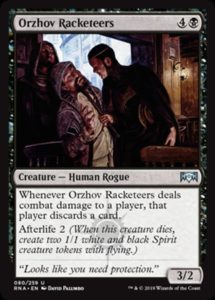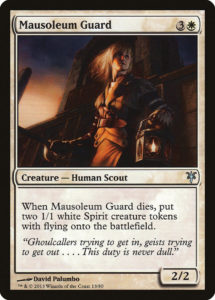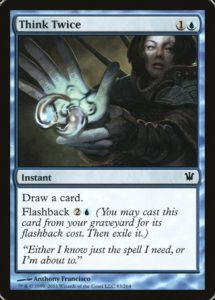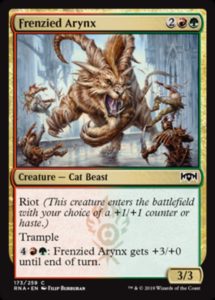Today, let’s do a deep dive into a card we haven’t yet had a chance to play with: Orzhov Raceketeers.
Paying a Lot for a Little
I don’t know what you thought when you first saw this card, but I thought it looks pretty darned weak. I’m not excited to play a Warpath Ghoul or a Headhunter. But stick ’em together and make them an eminently blockable five drop? Yeeeugh. This starts to look like Rakdos Ringleader: weak, costly, and annoying at best.
This strong emotional reaction makes sense—we’re looking at the card’s cost-to-stars ratio and the bulk of the (non-reminder) text on the card. That saboteur ability is hardly synergistic with its high mana cost and lack of evasion. It’s easy to discount the value of the death trigger, however. I suspect that when we play with the card, we’ll find that our initial impression missed most of the card’s power, which is hidden in that single word (plus a number) ability. But to evaluate Afterlife properly, we need to look at precedent.
Morbid Value
Mausoleum Guard is a similarly unassuming creature with similar stats, cost, and ability. We expect our 2/2s for two mana to come with upside. For four mana, we expect a lot of upside, something like Gallant Cavalry that provides immediately value and an impressive 4/4 in total stats. Mausoleum Guard makes us wait for our value, though when it comes, it comes with flying (which is worth an extra mana or two). Additionally, Mausoleum Guard exists on Innistrad, a world where profitable sacrifice outlets both make its hoop easier to jump through and provide additional value for the additional bodies. Funnily enough, the Orzhov also like sacrificing creatures for profit.
Mausoleum Guard looks unassuming, but its hidden utility and evasive tokens make it more than the sum of its parts. In fact, many of the best common creatures in previous formats are small creatures that come with both evasion and a token. Sandsteppe Outcast, Eldrazi Skyspawner, and Dauntless Cathar are fantastic cards, and Nearheath Chaplain was a bomb uncommon. I wouldn’t argue that Orzhov Racketeers is better than any of the aforementioned cards, but they do all belong to the same value-producing family. And whereas those other cards were fairly unique in their environments, Orzhov Racketeers is very likely to be in decks alongside several other Afterlife creatures—no one of them needs to be amazing when all of them are serviceable.
Paying for a Lot
Afterlife is a card advantage mechanic. That’s both an enormous strength (every card is a built in X-for-1, where X = the Afterlife number + the creature itself) and a downside (where the card either has to cost extra or have worse stats to compensate). I’d wager that each point of Afterlife is worth ~0.75 mana (see this article for more info on how much other abilities cost), so Orzhov Racketeers could theoretically be a 4/4 or even a 5/4 instead—which is fine, but probably going to trade down in combat. Instead, you can trade it for a three or four drop; but while you’re down a bit on mana, your opponent goes down a card or two.
Context is Key
The question for how good Afterlife will be comes down to what the format looks like. Mentor forced creatures to be fairly small in Guilds of Ravnica, so a 3/2 for five that provided a bunch of value wouldn’t be too embarrassing. That said, this isn’t Guilds of Ravnica. Spectacle has the potential to let aggressive Rakdos decks compound early advantages and punish Orzhov players for playing slow, grindy decks. Powerful Gruul threats like Frenzied Arynx make Orzhov Racketeers look puny and can plow through little spirit tokens—even if they trade, the Gruul player gets more damage in. Simic’s Adapt mechanic means that the guild also pays a price premium for power, but cards like Aeromunculus are good without having to pay the Adapt premium, unlike Orzhov cards which pay for Afterlife in their mana cost. Moreover, a lone Aeromunculus single-handedly invalidates an entire spirit armada.
In short, there are a whole lot of unknowns regarding Afterlife. It’s a dangerously powerful mechanic. It could command too high a cost when the other guilds don’t have to pay a premium and can force the Orzhov player to two-for-one themselves just to stay alive. Or the Orzhov could merely look weak, making likely to be underdrafted and quite successful, much like Dimir was in Gatecrash. Only time and prerelease will tell, and I’m quite excited to find out just how powerful the Doomed Traveler mechanic is.
And, as always, thanks for reading.
—Zachary Barash is a New York City-based game designer and the commissioner of Team Draft League. He designs for Kingdom Death: Monster, has a Game Design MFA from the NYU Game Center, and does freelance game design. When the stars align, he streams Magic.
His favorite card of the month is Growth Spiral. Explore is one of his favorite designs ever, and this is not only the same card, but it avoids the complexities of playing extra lands. Also, have you seen that artwork by Seb McKinnon?





